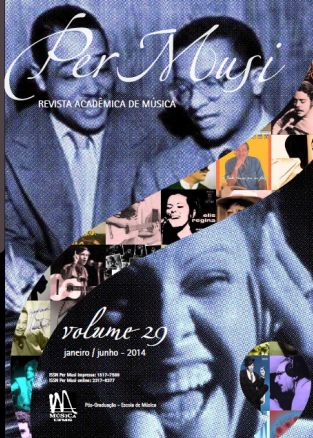Palavra escrita (Bilac, Iessiênin e Augusto de Campos) e palavra cantada (Toquinho e Belchior)
aspectos estilísticos do poema e da canção na Literatura e na MPB
Palavras-chave:
Estilística discursiva na música popular, Análise dialógica do discurso, Esferas discursivas e gênero de discurso, Literatura, poema e canção, Olavo Bilac, Sierguéi Iessiênin, Augusto de Campos, Toquinho, BelchiorResumo
Assumindo a Literatura e a Música Popular Brasileira enquanto práticas discursivas, nosso objetivo neste artigo é analisar os aspectos estilísticos de três enunciados dos gêneros poema e canção, produzidos respectivamente nas esferas discursivas literária e verbomusical, e que mantêm entre si um diálogo intertextual. Os textos analisados, sob a ótica dos estudos de Bakhtin e de seu Círculo, são o poema Até logo, até logo, companheiro, tradução de Augusto de Campos para texto de Sierguéi Iessiênin; a canção quase homônima, musicada por Toquinho a partir da tradução de Campos; e a canção Até mais ver, uma adaptação do poema de Iessiênin feita por Belchior, que dialoga também com o poema In extremis de Olavo Bilac. Em nosso estudo, verificamos como se dá a relação interdiscursiva, se de modo contratual ou polêmico, operada pelos autores-criadores Augusto de Campos, Toquinho e Belchior, a partir de Sierguéi Iessiênin.
Referências
ARISTÓTELES. Rhétorique. Paris: Les Belles Lettres, 1967.
BAKHTIN, M. Questões de literatura e de estética: a teoria do romance. Trad. de A. F. Bernadini et al. 3. ed. São Paulo: Hucitec, 1993. (Original: 1934-1935).
______. Autor y héroe en la actividad estética. In: Hacia una filosofía del acto ético. De los borradores y otros escritos. Trad. de T. Bubnova. Rubí (Barcelona): Anthropos; San Juan: Universidad de Puerto Rico, 1997a. (Original: 1924).
______. O autor e o herói na atividade estética (1920-1930); Os gêneros do discurso (1952-1953) e Apontamentos (1970-1971). In: Estética da criação verbal. Trad. a partir do francês de M. E. G. G. Pereira. 2. ed. São Paulo: Martins Fontes, 1997b. p.23-221; 277-326 e 369-397. (Original: 1979).
______. Problemas da Poética de Dostoiévski. Trad. de P. Bezerra. 2. ed. Rio de Janeiro: Forense Universitária, 1997c. (Original: 1963).
______. A cultura popular na Idade Média e no Renascimento: o contexto de François Rabelais. Trad. de Y. Frateschi. 4. ed. São Paulo: Hucitec; Brasília: Edunb, 1999. (Original: 1965).
BAKHTIN, M.; VOLOCHÍNOV, V. N. La construcción de la enunciación. In: SILVESTRI, A.; BLANCK, G. (Orgs.). Bajtín y Vigotski: la organización semiótica de la conciencia. Barcelona: Anthropos, 1993. p.245-276.
______. Marxismo e filosofia da linguagem. Trad. do francês de M. Lahud e Y. Frateschi. 11. ed. São Paulo: Hucitec, 2004. (Original: 1929).
BANDEIRA, M. Bandeira a Vida Inteira. Rio de Janeiro: Alumbramento, 1986. p.90.
BILAC, O. Poesias. São Paulo: Teixeira e Irmão, 1888.
______. Antologia poética. Guarulhos: Germapa, 2004.
BRAIT, B. Estilo. In: (Org.). Bakhtin: conceitos-chave. Org. B. Brait, Org. São Paulo: Contexto, 2005. p.79-102.
BUFFON, G. L. Discours sur le style, 1753. Disponível em: <http://www.buffon.cnrs.fr>. Acesso em: 01 fev. 2012.
CAMPOS, A. de; CAMPOS, H. de; SCHNAIDERMAN, B. (Tradutores). Poesia Russa Moderna. Rio de Janeiro: Civilização Brasileira, 1968. p.193. Edição original. (Poesia Russa Moderna. 2. ed. rev. e amp. São Paulo: Perspectiva, 1985. 2. edição; Poesia Russa Moderna. 6. ed. rev. e amp. São Paulo: Perspectiva, 2001. p.316. Coleção Signos 33. Edição mais recente.).
______. Maiakóvski/Poemas. 2. ed. São Paulo: Perspectiva, 1982. p.109. Coleção Signos. (Maiakóvski/Poemas. Rio de Janeiro: Tempo Brasileiro, 1967. Edição original; Maiakóvski/Poemas. 7. ed. 1. reimp. São Paulo: Perspectiva, 2006. p.109. Coleção Signos/Haroldiana. Edição mais recente.).
CARLOS, J. T. Muito além de apenas um rapaz latino-americano vindo do interior: investimentos interdiscursivos das canções de Belchior. 2007. 278 p. Dissertação (Mestrado em Linguística – área de concentração Análise do Discurso) – Programa de Pós-Graduação em Linguística, Universidade Federal do Ceará, Fortaleza, 2007.
DISCINI, N. O estilo nos textos. 2. ed. São Paulo: Contexto, 2004.
FOUCAULT, M. O que é um autor? Lisboa: Passagens/Vega, 2002.
______. A ordem do discurso. Trad. de L. F. de Almeida Sampaio. 9. ed. São Paulo: Loyola, 2003.
GRILLO, S. V. C. Esfera e campo. In: BRAIT, B. (Org.). Bakhtin: outros conceitos-chave. São Paulo: Contexto, 2008. p.133-160.
JAKOBSON, R. Linguística e comunicação. Trad. de I. Blikstein. 18. ed. São Paulo: Cultrix/Edusp, 2001. p.161-162.
TATIT, L. O cancionista: composição de canções no Brasil. São Paulo: Edusp, 1996.
______. Musicando a semiótica. São Paulo: Annablume, 1997.
______. Semiótica da canção: melodia e letra. 2. ed. São Paulo: Escuta, 1999.
______.Análise semiótica através das letras. 2. ed. Cotia: Ateliê, 2002.
VOLOCHÍNOV, V. N. Discurso na vida e discurso na arte (sobre poética sociológica). Trad. de C. Tezza e C. A. Faraco para uso didático. (Original: 1926).
Downloads
Publicado
Edição
Seção
Licença
Copyright (c) 2014 Per Musi

Este trabalho está licenciado sob uma licença Creative Commons Attribution 4.0 International License.

Exceto onde está indicado, o conteúdo neste site está sob uma Licença Creative Commons - Atribuição 4.0 Internacional.












